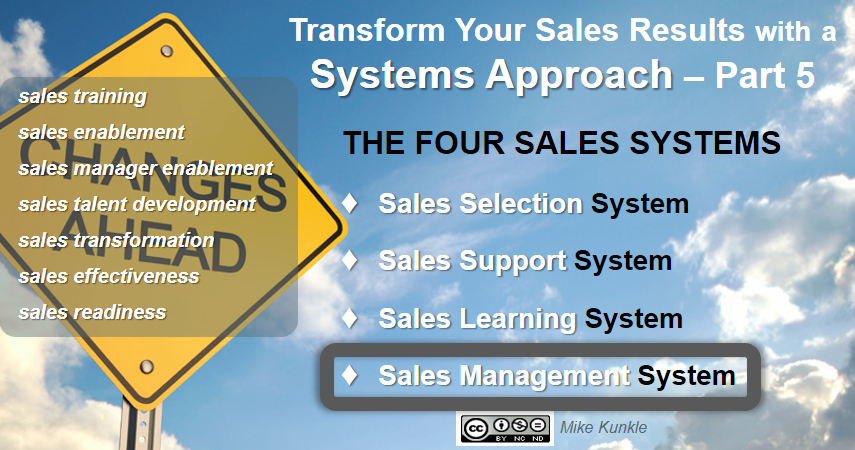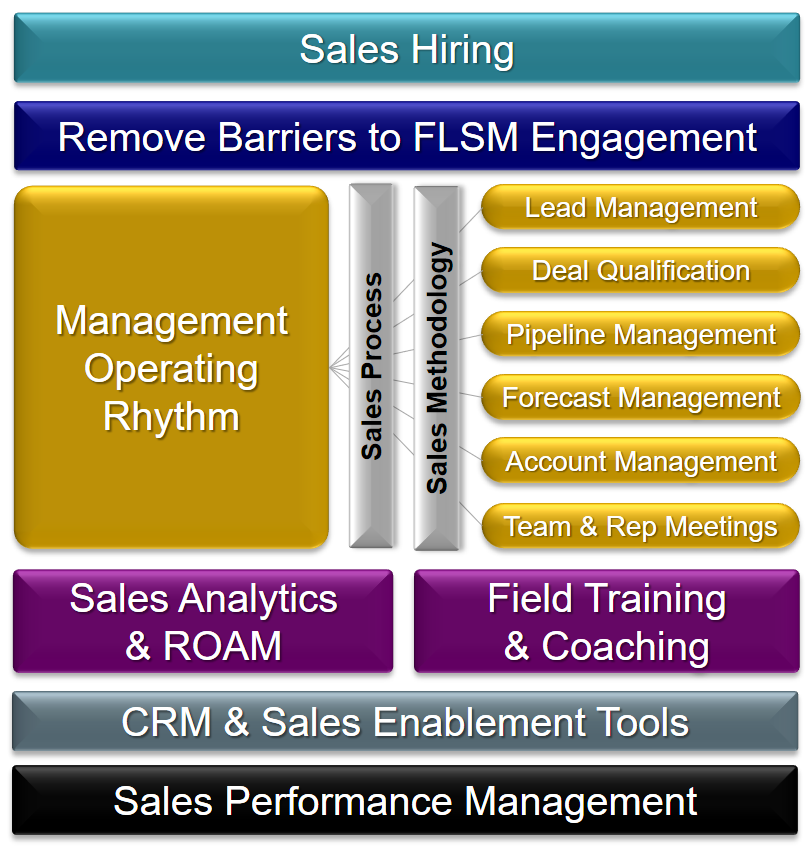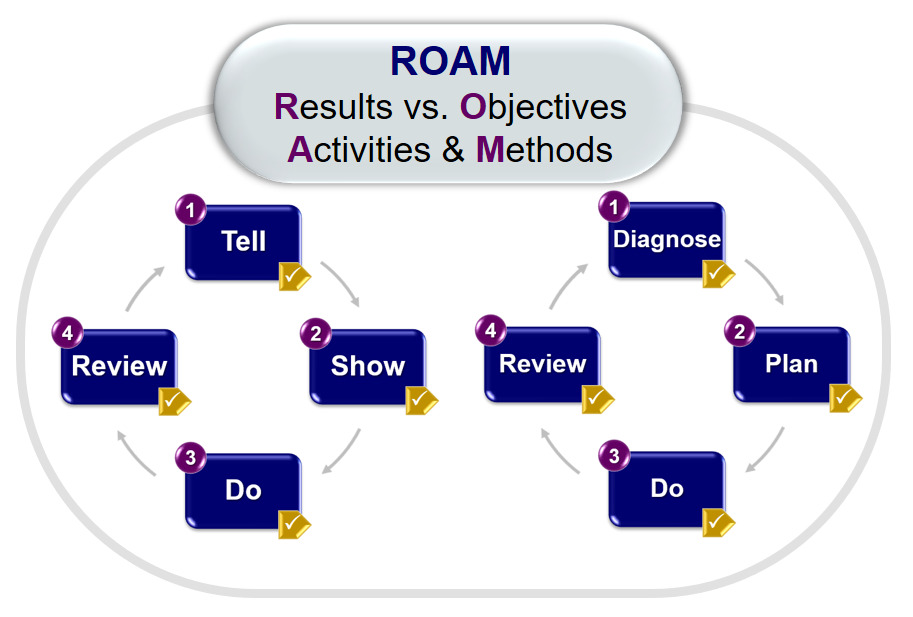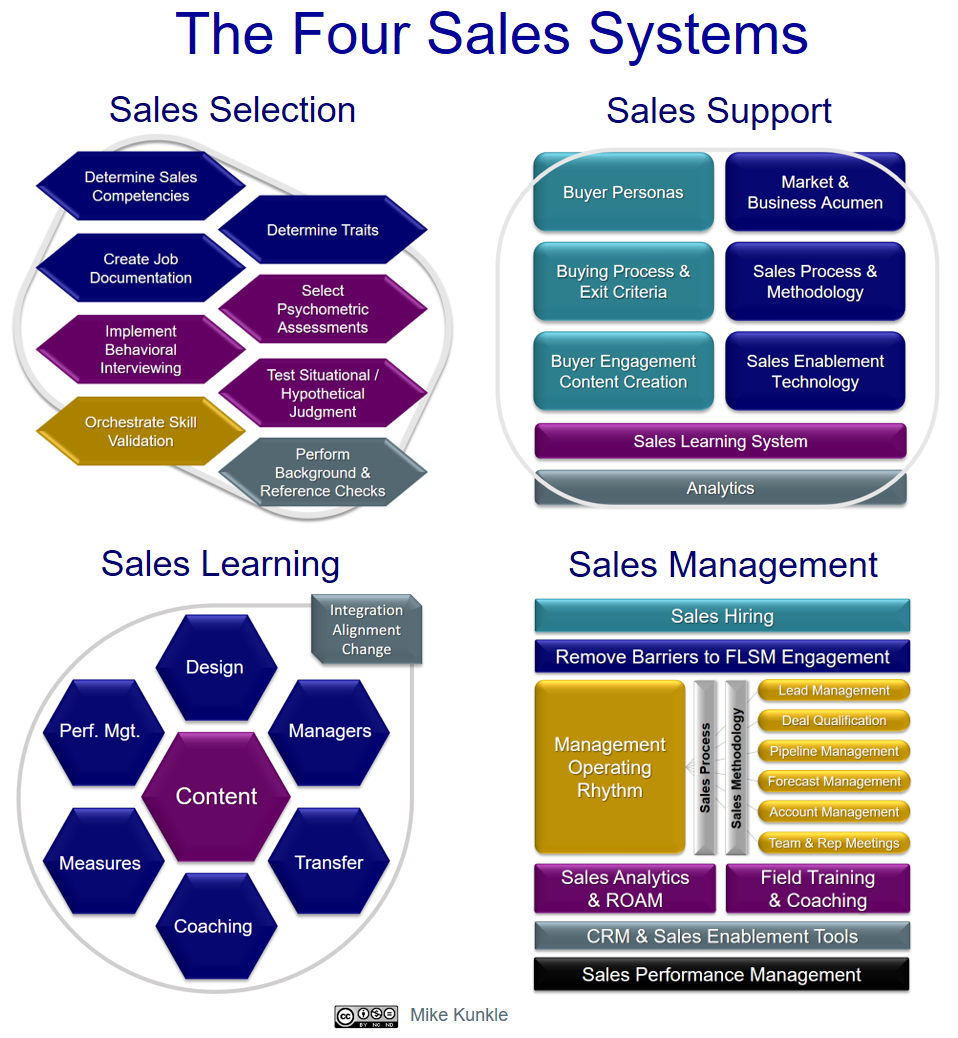Transform Your Sales Results with a Systems Approach – Part 5: Sales Management

In Part 1 of this series, I shared my belief that the solution to many of our current sales problems, and a viable vehicle for radically transforming your sales results, is a Systems Approach to Sales. The four systems I recommend as a starting point are:
In Part 2 of the series, I highlighted the Sales Selection System.
In Part 3 of the series, I shared the Sales Support System (previously, just “Selling System” – I’m renaming it).
In Part 4 of the series, I shared the of the Sales Learning System, which is a subset of the Sales Support System but important and detailed enough to call-out separately.
In this 5th post in the series, I will discuss the system that is critical to the execution, sustainment, and success of all the others – the Sales Management System.
The Sales Management System

Look at the components in this system, compared to the others. Note the larger number of components and the complexity involved. When you look closely, it becomes clear why the frontline sales manager role is one of the most challenging in corporations today.
Entire books have been dedicated to this topic and this could easily become one. Time and space prevent me from getting too detailed in just one post, but I will do my best to explain the system at the high level and provide other reading to fill in the gaps.
Sales Hiring
Sales Selection (hiring) is its own system, detailed in Part 2 of this series. The science and processes behind this system provide potential for great success. That potential will only be realized if the system is executed well, consistently. The Frontline Sales Managers (FSMs or FLSMs, I’ll use the latter) are the enabler or barrier to success for this system, which is why it’s included here, in the Sales Management System.
To be clear, managers are only peripherally involved in the creation of the system. Their feedback can be very helpful when creating job profiles, determining competencies and traits, and creating situations/case studies for testing hypothetical judgment or skill validations and simulations. At the same time, manager opinions and gut-feel should not override the science you are trying to implement or anything that is based on research and data vs. experience.
Where the FLSMs truly come in, is in the execution of the system:
- Reviewing results of psychometric assessments to prep for interviews
- Conducting behavioral interviews
- Leading or participating in other assessments and simulations
- Possibly making some reference calls (the sales-manager-to-former-sales-manager calls, possibly)
- Participating in interviewer feedback calibration sessions, to understand each interviewer’s perspective and make a final hiring determination
Get this right, and get your FLSMs engaged, bought-in, and executing effectively.
Remove Barriers to FLSM Engagement
I should probably move this up, given its importance, but wherever it sits in the graphic, this is a major key to success for FLSMs. As such, it’s worth calling out in the system as something that requires thought and focus.
- I wrote this post on Selling Power about a company that learned why their managers weren’t coaching (they were lumping far too many low-value requirements on their FLSMs). When addressed, the gains were tremendous.
- I wrote this post for Sales & Marketing Management about getting out of the “sales prevention business,” and while it’s mostly aimed at removing barriers for sales reps, the same thought process applies to your FLSMs.
Take a hard look at the expectations that are set for your FLSMs (or set them, clearly, if you haven’t), what success would look like, and what barriers your leadership team is tossing in their way, that prevent FLSMs from doing high-value activities with their team. Remove as many barriers as possible. Then ensure that your managers focus their new-found time on those high-value activities – most of which are other components in this system.
Management Operating Rhythm
Activities in a sales management operating rhythm (MOR), and the cadence at which they recur, may vary from company to company, based on a variety of factors (sales nuances). I’ve tried to select components here that are universal, or as universal as possible, but as always, use good judgment as to what is right for your business.
In the MOR graphic, think of:
- The operating rhythm (left) as the cadence for how often things occur.
- The Sales Process and Sales Methodology (middle) as the foundation for and context in which the activities to the right occur.
- The activities (right: Lead Management down through Team & Rep Meetings) as the things that managers do to execute the MOR. These may be variable and the ones listed here, while common, are intended to be representations versus mandates.
Sales Process
It seems obvious, perhaps, but managers must be experts with your sales process and the activities that occur within it. (Surprisingly, many sales managers I speak with can’t clearly articulate the difference between process and methodology, so perhaps it isn’t as obvious as it might seem.) Sales Process is the stages an opportunity progresses through to a buying decision.
- The Sales Process is like any other process documentation. It includes the process stages (in this case, the stages a sale moves through), the objectives of each stage, the tasks performed in each, and the desired outcomes of each (in this case, verifiable outcomes – and when properly aligned to the buying process – the buying process exit criteria).
- The Sales Process should be a response to the buyer’s journey, not a rigid, inside-out process that reps follow robotically. As discussed in Part 3 of the series on the Sales Support System, your Sales Process should not only be aligned to the buying process but also document the buying process exit criteria. (I’ll discuss that in more detail in Pipeline Management.) This alignment and documentation work isn’t performed by sales managers, but must be well understood and executed by them, through their sales teams.
- FLSMs should ensure that reps are identifying where buyers are in their buying process, responding appropriately, and documenting the opportunity record effectively in your CRM. This is the majority of what I mean by “Sales Process” here as a placeholder in the sales MOR, and will further detail other aspects as we progress through the activity components.
- Deal Qualification and Pipeline Management are also part of Sales Process, but I’m choosing to call them out separately as activities that occur within the Sales Process and Sales Methodology.
Sales Methodology
Sales Methodology is what the reps do in each stage of the sales process that is sales skill related… the skills, competencies, and behaviors they use while navigating through the process with their buyers. It does not include all process tasks, since not all process tasks are sales skills.
Whatever Sales Methodology you use, your FLSMs must be expert at it, recognize when reps are or aren’t using it (activity – what and how much) and to what degree (quality), and be able to coach reps to higher levels of skill performance, which should lead to better sales results.
Methodology ties back to the Sales Support System (where it is applied) and the Sales Learning System (where it is taught, sustained, transferred and coached to mastery), so I won’t detail it further here. By placing it here, I am simply suggesting that FLSMs must understand the methodology best practices, and be able to diagnose, train, coach, and support the chosen Sales Methodology.
Lead Management
So much of this is based on the sales role being supported, how Marketing is handling Demand Generation, whether or not there is a Sales Development team, and more. This makes it difficult to recommend a universal model. However your company drives leads, and however your sales force is involved in lead generation, prospecting, and Lead Management, your FLSMs must be expert at what reps are expected to do in your company, and be able to field train and coach accordingly.
This might include thing like:
- Social research, social marketing, and social nurturing
- Other territory, account, and contact research
- Trigger Event and alerts monitoring
- Taking Marketing or SDR hand-offs and following up quickly yet effectively
- Qualifying leads
- Entering leads and opportunities appropriately in your CRM
- Using the supporting Sales Enablement tools (a separate component but it applies here), and more
Deal Qualification
Whatever you call it (lead, deal, opportunity, or sales qualification), and whatever qualification system you use (there are many), being able to train, coach, and manage a qualification method is a key component to sales management. There are some obvious cross-overs between this skill and Pipeline Management (aka Opportunity Management or Funnel Management) and forecasting, but I believe that qualifying is so important and so often done poorly, that it deserves to be called out and addressed specifically.
Hopefully you are using a scoring system and can capture and track it in your CRM to create visibility and foster accountability, but that’s another topic for another day.
Pipeline Management
As mentioned above, many of these components intertwine. Pipeline Management, for example, is linked to Sales Process, Sales Methodology, Deal Qualification, and Forecast Management.
To me, the hidden magic and performance lever of Pipeline Management is the work of uncovering the buying process exit criteria per buyer/decision-maker and meeting those criteria, to gain continual commitments to move forward to the next stage. (Buying process exit criteria includes anything a buyer needs to see, hear, feel, touch or believe in the stage they’re in, to feel comfortable moving forward to the next stage with you.)
You might remember that this is covered in the Sales Support System. FLSMs must be expert in Pipeline Management, how to conduct pipeline review sessions, and be able to train, guide and coach their reps to do it expertly. Combine this with Deal Qualification and your pipeline health will improve dramatically (as will your forecast). I see this as of one of simple truths about selling that is often overlooked or done poorly.
Forecast Management
Books and countless ebooks, briefs, white papers, articles, and blog posts have been written about forecasting. Software products and companies exist with the sole purpose of better supporting this discipline. Yet, research and company performances worldwide continually prove that many can’t do this well. Mostly that’s because they don’t do the other things well that have led up to this point.
Great forecasting is a culmination of doing other things well. Do the other activities well, and forecasts improve. Sound Deal Qualification, Sales Process alignment, great Pipeline Management, and the effective execution of your Sales Methodology, will yield higher-quality opportunities with more accurate assessments of their status. This means deals will be more predictable than average, yielding far better than the low-level of forecasting accuracy that we see today.
And yes, managers must be experts in forecasting and guide reps to do what’s necessary, to allow them to forecast well. If you fix the other things, forecasting will improve. Pushing for weekly or month-end updates from reps to meet a forecast need, and then fudging most of that data or applying random filters to what you believe or don’t, will not ever result in a good forecast. Although I could sell a lot of Magic 8 Balls at month-end, I bet, if I tried.
Account Management
Again, here’s some overlap. I could have easily put this under Sales Methodology (it is one), but felt it should be called out specifically.
Why? I see way too few sales call objectives (and back-up objectives), call plans, account objectives, factor analyses, force field analyses, account plans, or the gathering, sharing and using of account intelligence, or many other aspects of strategic account management. Way too many Sales Methodologies are incomplete, focusing on subsets of selling, while missing the importance of end-to-end customer lifecycle management. (Among many other things, this is one thing I especially respect about Performance Methods, Inc. (PMI), and Steve Andersen/Dave Stein’s book, Beyond the Sales Process. I highly endorse both PMI and Steve’s/Dave’s book.)
Managers must be experts here, as well, and guide their teams toward far better strategic account management.
Team & Rep Meetings
There are various team and individual meetings that sales managers should lead, in some predetermined cadence. These may vary by company, so you should determine the right meetings, establish an expected cadence, and execute consistently. The meetings might include:
- A weekly, biweekly, or monthly team meeting (or short weekly meetings with a longer more robust monthly meeting)
- Pipeline meetings with the team
- Individual pipeline and performance review meetings
- Forecasting meetings (separate from pipeline management)
- Performance observation: Sales call “listen-ins” (live and recordings) or field meeting “ride-alongs” (live and recordings) and the resulting field training and coaching follow-ups
- Best-practice sharing or team training meetings
- If you use a virtual coaching tool (and you should), that can be used in either an established cadence, or ad-hoc, as needed and preferred.
Sales Analytics & ROAM

Sales Analytics
From my experience, it almost seems as if we expect that FLSMs will understand how to pull, review, interpret and use Sales Analytics through osmosis or magic. Also from my experience – it doesn’t work that way.
Most people who move into sales management roles from frontline sales roles, haven’t given much consideration to how activity metrics, lead and lag indicators, and other reporting have a dot-connection to skills and behaviors, and how the analytics can be used to diagnose areas for improvement.
When I present this slide deck which is (partly) about sales analytics, there are always plenty of light-bulbs going off and people coming up to me afterward to share the connections they made for the first time.
Based on a webinar I attended recently with Dave Brock (it was excellent) and this post he published afterward, it seems I’m not alone in thinking many managers don’t really understand what I call Sales Math (what the numbers really mean).
If you don’t offer such training for your sales managers, you should. Stop believing in magic. (Except for David Blaine. He’s creepy good.)
ROAM
ROAM is a sales diagnostic model that:
- Helps managers know where to focus coaching efforts for the great return.
- How to dissect what’s happening and not working, to fix it.
The acronym means:
- Results vs. Objectives (comparing, to identify gaps or shortfalls in Results)
- Activity (review what they’re doing and how much)
- Methodology (determine the quality of the activity, or how they’re executing the Sales Methodology)
I first used the method (originally as just RAM) in 2004, as part of a program I designed called Partnership Coaching, and got great results. I’ve used it many times since and have never seen it fail, if it was executed well.
I first published the concept publicly as RAM on LinkedIn in 2014, ten years after its debut, once I started publishing content openly. I ported it over to my own blog in early 2015.
I added Objectives just recently, thanks to the influences from my friends and respected sales management experts at Vantage Point Performance and due to a post that my buddy and sales expert, Tibor Shanto of Renbor Sales Solutions, published for Brainshark when I was working there.
- First, Jason Jordan (of Vantage Point) published this post about a variety of coaching models. It’s a great post and you’ll see I posted a comment on it, mentioning my RAM model and that I was considering adding O for Objectives to my model. (By the way, if you haven’t read Jason and Michelle Vazzana’s stellar book, Cracking the Sales Management Code, you should.)
- Then Tibor Shanto wrote a guest post for Brainshark, introducing his concept of Objective-Based Selling. Tibor “gets it” in general and his prospecting work is stellar, but his concept of Objective-Based Selling is even sharper, in my opinion. Check it out in moer detail at his own blog: http://www.sellbetter.ca/category/objective-based-selling/
Since in “Results,” I was already asking managers to look at results versus objectives to find shortfalls and areas on which to focus, I finally added an O to the model to officially make it ROAM, in 2016.
Since I’ve already explained briefly what ROAM means and have the below resources for you to review, I hope you’ll forgive that I don’t go into more detail here.
- Blog post about using pipeline diagnostics: https://www.linkedin.com/pulse/20140719203006-834966-sales-coaching-practices-that-get-big-results
- Blog post about RAM: https://www.mikekunkle.com/2015/02/07/for-better-sales-coaching-results-ram-your-reps/
- Brainshark Post about ROAM leading to a podcast with Barb Giamanco: https://www.brainshark.com/ideas-blog/2016/December/using-roam-method-for-sales-training-and-coaching
- Direct link to Barb’s podcast: http://barbaragiamanco.com/improve-field-training-and-sales-coaching-with-mike-kunkle/
- Webinar on Brainshark’s platform about ROAM and my Field Training & Coaching Models: https://www.brainshark.com/campaigns/lp/demand-webinar-training-coaching-equals-greater-sales-productivity (applies to the below section as well)
Field Training & Coaching
Field training and coaching aren’t rocket science. It just takes a top-down commitment to the need, the willingness to remove barriers, teaching these simple methods, setting up a system to capture coaching and track results, and the willingness to hold managers accountable for doing it.
In addition to the detailed webinar mentioned above, here are some resources that already exist about the models:
- The slides from the above webinar, on SlideShare:
- A SlideShare presentation that I delivered at GE Capital’s Mid-Market Summit:
- Publisher post on the the models: https://www.linkedin.com/pulse/20141020050435-834966-simple-methods-to-improve-sales-rep-performance
CRM & Enablement Tools
These should be obvious, but I can’t tell you how many times I’ve worked at companies where the managers barely knew how to use the CRM system and needed constant assistance. And when that was the case, expecting them to be able to explain why the sales enablement tools were needed and how to use them effectively, was a lost cause.
Folks, if Frontline Sales Managers can’t get a handle on technology and master it, I simply don’t know how they will thrive in the coming years. This is 2017. Rolodexes, card files, and doing everything manually are practices of a bygone era.
Make the expectations crystal clear, and give managers the rationale and ROI case, the training, the practice if needed, and the support they need, to maximize the tools and help their reps do the same.
Sales Performance Management
Part of Sales Performance Management is embedded in the Sales Learning System (to perpetuate skills taught and cement change in the culture) and is something at which managers must excel. If we know the behaviors that produce results for reps, reps should be held to that standard (for the activities, methodologies and the results), and their performance should be managed accordingly. And… the same is true for the Frontline Sales Managers. Performance management should be a cultural expectation, applied with positive, helpful intention, as part of the fabric of the sales organization.
Lest it seem unfair that the sales organization is managed so rigorously, perhaps even beyond any other function, remember this:
- Other departments can add tremendous value to clients and the organization.
- Other departments can create risk for the organization or take it down (Accounting mismanaged, is a nightmare, for example).
- But with the possible exception of Marketing (with the growing emphasis on Demand Generation, ABM and marketing-driven revenue assignment), there is no other department or function that can save the company, if Sales does not perform.
Nothing happens until somebody sells something. So, treat your Sales team well, encourage engagement, listen and solve their problems, invest in infrastructure and their training and development. Do all of that. But also manage their performance and hold them accountable, with Sales Performance Management. Frontline Sales Managers must know how to do this, and do it well.
But today, Sales Performance Management is even more than that. Gardner recently published its 2017 report, Critical Capabilities for Sales Performance Management. In it, Gartner describes SPM solutions as:
“…a suite of operational and analytical functions that automate and unite back-office operational sales incentives processes. SPM is implemented to improve sales execution and operational efficiency.
Capabilities include:
– sales incentive compensation management (ICM)
– objectives management
– quota management and planning
– territory management and planning
– advanced analytics (benchmarking, predictive and prescriptive, and machine learning/cognitive)
– gamification.”
The most powerful statement in Gartner’s report, to me, speaks to the potential of SPM and the supporting software, and why everyone should be considering it:
“SPM accelerates representatives’ time to value by providing real-time visibility into pay and performance. It provides opportunity estimation of expected commissions, thus encouraging sales representatives to keep more accurate forecasting in the CRM system, and provides motivation for increased close rates on profitable sales. SPM, bridged with CRM, raises execution results of companies’ go-to-market efforts with the execution of more effective compensation plans at the territory and field representative levels.”
At a minimum, we must have frontline sales managers actively engaged in pipeline management, forecasting, and rep performance management, with sales analytics with the corresponding field training and coaching. At best, it’s also time to explore the possibilities that SPM software can offer, to further support your managers and sales force.
And with that, I will end this 5th and final post in this series (A Systems Approach to Sales) on the Sales Management System. I hope this post, and the entire series, has been thought-provoking and valuable for you.
Author Note:
You can find Part 1 here, Part 2 here, Part 3 here, and Part 4 here and Part 5 here.
_____________________________________________________________
As always, this is what I think. More importantly… What do YOU think?
I have poured myself into this series and spent countless hours on these 5 posts. I’d sincerely enjoy hearing your thoughts, experiences, questions, suggestions, or even disagreements or rants in the Comments section. If you enjoy this post, please feel free to share it with others. I appreciate it.
Thanks for reading, be safe out there, and by all means — let’s continue to elevate our sales profession and evolve, elevate and professionalize the Sales Enablement function.
Mike Kunkle
:: transforming sales results ::
Let’s get connected:
- Blog: http://www.transformingsalesresults.com
- LinkedIn Publisher Posts: http://bit.ly/MikeKunklePublisher
- Sales Transformation Straight Talk Webinars: http://bit.ly/STSTonSMM
- The Sales Experts Channel Webinars: http://bit.ly/SalesExpertsChannel
- LinkedIn: http://www.linkedin.com/in/mikekunkle
- Twitter: https://twitter.com/mike_kunkle
- SlideShare: http://www.slideshare.net/mikekunkle
- Google+: https://plus.google.com/u/0/+MikeKunkle
_____________________________________________________________
sales transformation | sales force transformation | sales training | sales talent development | sales enablement | sales force enablement | sales manager enablement | sales readiness | sales effectiveness | sales optimization







